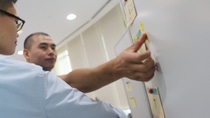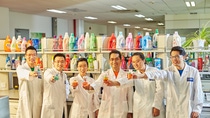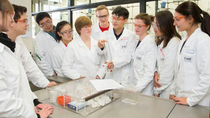Inspire innovation and grow with the Innovation Campus
“R&D professionals are the foundation of innovation. We have created many opportunities for them at the Innovation Campus Asia Pacific and we encourage them to conduct scientific research projects with application value.”
Dr.Helmut Winterling, Senior Vice President of Dispersion & Colloidal Materials Research, BASF
.jpg)
Sydney Peng, a scientist who joined BASF’s Care Chemicals Research Laboratory at the Innovation Campus in Shanghai in 2016, recently got to know more of her colleagues during a special occasion – Afternoon Mind Refresh, an idea competition where she won the first prize for this round.
Afternoon Mind Refresh is an event for regular idea sharing and discussion that encourages R&D professionals to find problems in their lives and work and put forward innovative solutions. In doing so, it can turn ideas into projects with close follow-up measures to drive technological innovation and business growth. Three rounds of the competition, which is open to all R&D professionals at the Innovation Campus in Shanghai, have been held since 2016.
“Here we have created an open atmosphere for people to exchange ideas through vivid presentations,” said Dr.Helmut Winterling, the Senior Vice President of Dispersion & Colloidal Materials Research, BASF and sponsor of Afternoon Mind Refresh. “Throughout the process we have met many aspiring colleagues who are not only intelligent but also strongly motivated to drive innovation in their daily work.”
At the idea competition in March 2017, Sydney pitched to “increase the drying speed after shampooing without adding other steps”. Her proposal came from life experience: “Many of my friends, especially girls with long hair, have such a problem: every time they need to spend half an hour to dry their hair. I have been thinking whether I can find a solution to help them.”
As a newcomer to the company, Sydney works on well-developed projects with preliminary results. After learning of the activity, she immediately signed up for it. The proposal was entirely initiated and led by her, which made her excited. “It seems that it was my own baby.”
Like Sydney, Zhang Mengyu, a former chemist in Construction & Coating Material Research at the Innovation Campus in Shanghai, led her own project for the first time thanks to Afternoon Mind Refresh. Since joining BASF in 2014, she has been assisting her lab leader to do experiments in daily work.
She focuses on construction materials R&D and got an idea to develop a “smart” flooring material that can work in any environment.
To materialize the project, one needs to first learn how to present his or her ideas and gain support. Afternoon Mind Refresh allows only five minutes for each presentation. Before the formal presentation, Mengyu did many exercises but was always entangled in the technical details.
“You should introduce your idea from a listener’s perspective, and this person is very likely to have no knowledge of the field,” Her colleagues gave her a suggestion. Mengyu sorted out her thought: Why do I do such a thing and how do I achieve it? It helped her get the jury’s acceptance and she was lucky to win the activity.
To be a project leader, the winner should think more than the perspective of R&D. Since participating in the competition, Mengyu’s cross-unit collaboration capabilities have been improving. “I need to jump out of the box of ‘chemist’.” In the past, as a chemist, she only needed to consider whether the technology could be realized, and how to test, among other considerations. Now she needs to listen more, perceive market demands, consider commercial prospects and avoid policy risks. For this young lady, these are new experiences.
During the proposal preparation, in order to understand the usage scenario of flooring materials, Mengyu inquired among colleagues from business units about the pain points of floor materials in actual use. She found out that temperature was an important factor affecting floor construction and eventually confirmed the proposal of “smart” flooring material.
As the project proceeded, Mengyu met more colleagues whose work was related to her project but from different units. “I happened to know that a product from another team had something in common with my ‘smart’ flooring materials technical-wise, so I established contact with the help of the idea council and received a lot of guidance.”
For Sydney, the connections she built through the competition will benefit her future work. Through the initiative she met more colleagues from business units who gave her suggestions and ideas from the market perspective, inspiring her from different viewpoints. “In the R&D process, the ideas of colleagues of different units help me think my R&D ideas better.”
Different from Sydney Peng and Zhang Mengyu, Jerry Cao’s work in engineering R&D is closely related to production. His innovation focuses on chemical and process engineering. He is good at using computers to simulate materials, energy and process units so as to solve production problems in the industrialization process and improve production efficiency. He has now successfully transferred from a process engineering scientist to a process manager at the BASF Shanghai Caojing site. In future, he will continue his work in process and plant operation.
When he joined the company, Jerry was sent to BASF headquarters in Ludwigshafen, Germany, for nine months of training. Besides learning work-related skills systematically, he also participated in several practical projects. “In terms of process and engineering, Germany has a wealth of experience,” said Jerry. “Real project experiences help me to understand the importance of cooperation between different units and to accumulate a lot of expert contacts.”
And the shift comes from actual work. “I had project experience in the university before but this is the first time that the experience is so closely combined with actual production,” said Jerry. “In the projects at university, my goal was to ‘get the experimental results and understand the phenomenon’, but in actual production I need to think from the perspective of the plant and business: ‘Why do I do this?’ ‘What does this problem indicate?’ In this way, I provide not only a report but a set of solutions.”
In June 2016, Jerry undertook a project: a BASF plant needed to change part of its process from manual control to automatic control. It seemed that “manual” was replaced with “automatic”, but after communicating with plant and business units, reading previous project reports and consulting the headquarters about the experience of other countries, he found that besides automation, the plant could further reduce its cost by optimizing the operation parameters according to market prices of raw material and products.
After that, Jerry developed a simulation tool that could automatically calculate several key operating parameters by entering a few factors affecting the production, thus guiding the plant to achieve optimal operational efficiency. After the tool validation was complete, he worked with the engineering department to adjust the model according to feedback from actual production data.
“Good simulation tools require continuous debugging of accurate data. The accumulation of BASF’s first-hand production data provides a solid foundation for innovation,” he said.
In addition, BASF’s global laboratory resources can be deployed on demand. “BASF has first-class experimental facilities and, if necessary, colleagues can measure the required experimental data in laboratories," said Jerry. “In a multinational company, our projects are often done with the help of multinational colleagues. We look for the most viable solutions throughout the world, which makes me think further when considering problems.”
Sydney’s quick-drying experiment also requires multiple laboratory resources. The German headquarters can provide product testing, while China has a strong analytical center that can support relevant follow-up analysis.
“R&D professionals are the foundation of innovation,” said Winterling. “We have created many opportunities for them at the Innovation Campus Asia Pacific and we encourage them to conduct scientific research projects with application value. We look forward to seeing more innovative ideas to become product innovations in the future.”




